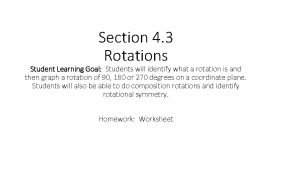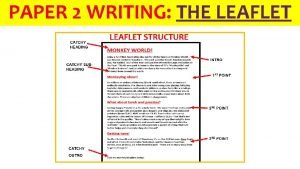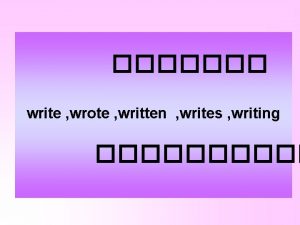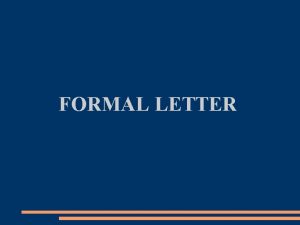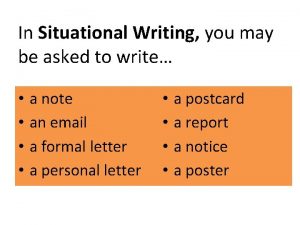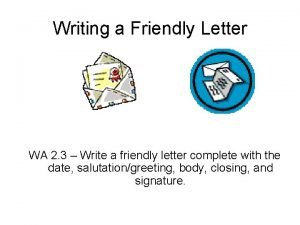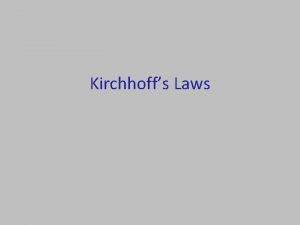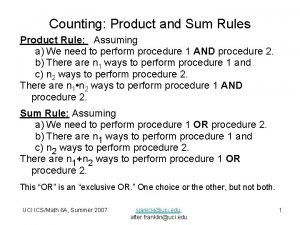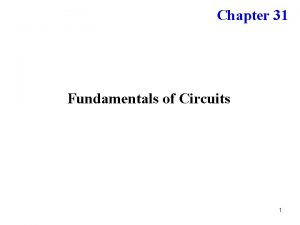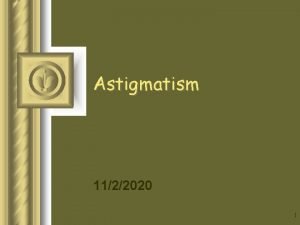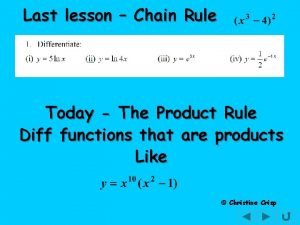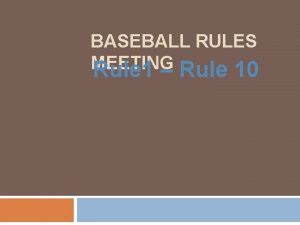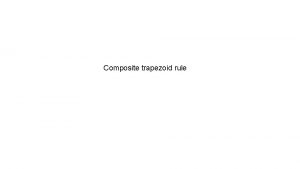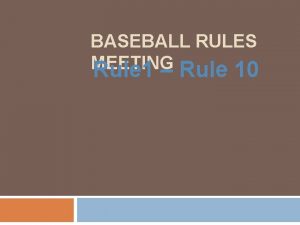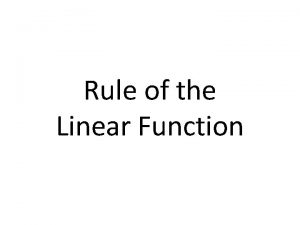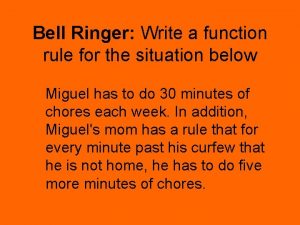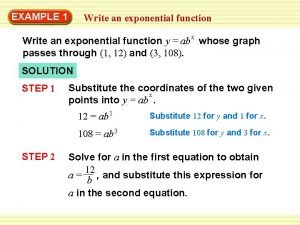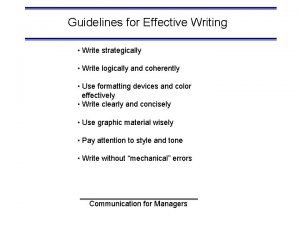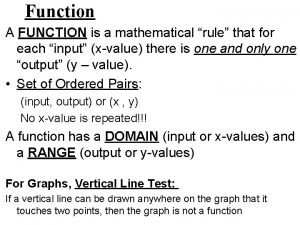WRITING A FUNCTION RULE WRITE A FUNCTION RULE
























- Slides: 24

WRITING A FUNCTION RULE:



WRITE A FUNCTION RULE FROM THE TABLE: x F(x) 1 -1 2 0 3 1 4 2

WRITE A FUNCTION RULE FROM THE TABLE: x F(x) 1 -1 2 0 3 1 4 2 Ask yourself, “What can I do to 1 to get to -1, 2 to get to 0…. ?

WRITE A FUNCTION RULE FROM THE TABLE: x F(x) 1 -1 2 0 3 1 4 2 Ask yourself, “What can I do to 1 to get to -1, 2 to get to 0…. ? Subtract 2 from each input value.

WRITE A FUNCTION RULE FROM THE TABLE: x F(x) 1 -1 2 0 3 1 4 2 Ask yourself, “What can I do to 1 to get to -1, 2 to get to 0…. ? Subtract 2 from each input value. So, f(x) equals x minus 2.

WRITE A FUNCTION RULE FROM THE TABLE: x F(x) 1 -1 2 0 3 1 4 2 Ask yourself, “What can I do to 1 to get to -1, 2 to get to 0…. ? Subtract 2 from each input value. So, f(x) equals x minus 2. f(x) = x – 2

WRITE A FUNCTION RULE FROM THE TABLE: x f(x) -4 -2 -2 -1 6 3 8 4 Ask yourself, “What can I do to -4 to get to -2? ” to -2 to get to -1…?

WRITE A FUNCTION RULE FROM A VERBAL EXPRESSION, AND SOLVE USING THE RULE:

WRITE A FUNCTION RULE FROM A VERBAL EXPRESSION, AND SOLVE USING THE RULE: Your uncle Fred loaned you $210 to buy a lawn mower. You charge $35 to mow one lawn. Write the function rule for your profit. Determine the breakeven point.

WRITE A FUNCTION RULE FROM A VERBAL EXPRESSION, AND SOLVE USING THE RULE: Your uncle Fred loaned you $210 to buy a lawn mower. You charge $35 to mow one lawn. Write the function rule for your profit. Determine the breakeven point. Profit is equal to income less the expense.

WRITE A FUNCTION RULE FROM A VERBAL EXPRESSION, AND SOLVE USING THE RULE: Your uncle Fred loaned you $210 to buy a lawn mower. You charge $35 to mow one lawn. Write the function rule for your profit. Determine the breakeven point. Profit is equal to income less the expense. Profit is the dependent variable since it depends on the number of lawns you mow.

WRITE A FUNCTION RULE FROM A VERBAL EXPRESSION, AND SOLVE USING THE RULE: Your uncle Fred loaned you $210 to buy a lawn mower. You charge $35 to mow one lawn. Write the function rule for your profit. Determine the breakeven point. Profit is equal to income less the expense. Profit is the dependent variable since it depends on the number of lawns you mow. Therefore, the independent variable is the number of lawns mowed, and represents the income.

WRITE A FUNCTION RULE FROM A VERBAL EXPRESSION, AND SOLVE USING THE RULE: Your uncle Fred loaned you $210 to buy a lawn mower. You charge $35 to mow one lawn. Write the function rule for your profit. Determine the breakeven point. Profit is equal to income less the expense. Profit is the dependent variable since it depends on the number of lawns you mow. Therefore, the independent variable is the number of lawns mowed, and represents the income. The constant quantity is the cost of the lawn mower, and represents the expense.

WRITE A FUNCTION RULE FROM A VERBAL EXPRESSION, AND SOLVE USING THE RULE: Your uncle Fred loaned you $210 to buy a lawn mower. You charge $35 to mow one lawn. Write the function rule for your profit. Determine the breakeven point. Profit is equal to income less the expense. Profit is the dependent variable since it depends on the number of lawns you mow. Therefore, the independent variable is the number of lawns mowed, and represents the income. The constant quantity is the cost of the lawn mower, and represents the expense. At the breakeven point there is no profit, p(m) = 0

WRITE A FUNCTION RULE FROM A VERBAL EXPRESSION, AND SOLVE USING THE RULE: Your uncle Fred loaned you $210 to buy a lawn mower. You charge $35 to mow one lawn. Write the function rule for your profit. Determine the breakeven point. Profit is equal to income less the expense. Profit is the dependent variable since it depends on the number of lawns you mow. Therefore, the independent variable is the number of lawns mowed, and represents the income. The constant quantity is the cost of the lawn mower, and represents the expense. At the breakeven point there is no profit, p(m) = 0 m = number of lawns mowed

WRITE A FUNCTION RULE FROM A VERBAL EXPRESSION, AND SOLVE USING THE RULE: Your uncle Fred loaned you $210 to buy a lawn mower. You charge $35 to mow one lawn. Write the function rule for your profit. Determine the breakeven point. Profit is equal to income less the expense. Profit is the dependent variable since it depends on the number of lawns you mow. Therefore, the independent variable is the number of lawns mowed, and represents the income. The constant quantity is the cost of the lawn mower, and represents the expense. At the breakeven point there is no profit, p(m) = 0 m = number of lawns mowed p(m) = profit (profit is a function of m)

WRITE A FUNCTION RULE FROM A VERBAL EXPRESSION, AND SOLVE USING THE RULE: Your uncle Fred loaned you $210 to buy a lawn mower. You charge $35 to mow one lawn. Write the function rule for your profit. Determine the breakeven point. Profit is equal to income less the expense. Profit is the dependent variable since it depends on the number of lawns you mow. Therefore, the independent variable is the number of lawns mowed, and represents the income. The constant quantity is the cost of the lawn mower, and represents the expense. At the breakeven point there is no profit, p(m) = 0 m = number of lawns mowed p(m) = profit (profit is a function of m) Your profit equals your income minus your expenses

WRITE A FUNCTION RULE FROM A VERBAL EXPRESSION, AND SOLVE USING THE RULE: Your uncle Fred loaned you $210 to buy a lawn mower. You charge $35 to mow one lawn. Write the function rule for your profit. Determine the breakeven point. Profit is equal to income less the expense. Profit is the dependent variable since it depends on the number of lawns you mow. Therefore, the independent variable is the number of lawns mowed, and represents the income. The constant quantity is the cost of the lawn mower, and represents the expense. At the breakeven point there is no profit, p(m) = 0 m = number of lawns mowed p(m) = profit (profit is a function of m) Your profit equals your income minus your expenses Profit = 35 times the number of lawns mowed minus cost of the mower.

WRITE A FUNCTION RULE FROM A VERBAL EXPRESSION, AND SOLVE USING THE RULE: Your uncle Fred loaned you $210 to buy a lawn mower. You charge $35 to mow one lawn. Write the function rule for your profit. Determine the breakeven point. Profit is equal to income less the expense. Profit is the dependent variable since it depends on the number of lawns you mow. Therefore, the independent variable is the number of lawns mowed, and represents the income. The constant quantity is the cost of the lawn mower, and represents the expense. At the breakeven point there is no profit, p(m) = 0 m = number of lawns mowed p(m) = profit (profit is a function of m) Your profit equals your income minus your expenses Profit = 35 times the number of lawns mowed minus cost of the mower. p(m) = 35 m – 210

TO FIND THE BREAK EVEN POINT, SET THE PROFIT EQUAL TO ZERO.

TO FIND THE BREAK EVEN POINT, SET THE PROFIT EQUAL TO ZERO. 0 = 35 m – 210

 Cache memory adalah
Cache memory adalah Transport number chemistry
Transport number chemistry Write the rule for this translation slide 3 up and 2 right
Write the rule for this translation slide 3 up and 2 right Write a rule to describe each transformation
Write a rule to describe each transformation Arithmetic sequence diagram
Arithmetic sequence diagram Sentence of leaflet
Sentence of leaflet Write, wrote, written
Write, wrote, written Professional letters
Professional letters Conclusion for notice writing
Conclusion for notice writing Rules of writing letters
Rules of writing letters Informal situational writing
Informal situational writing Heading for letter
Heading for letter Write wrote written writing
Write wrote written writing Trigonometry magic triangles
Trigonometry magic triangles Trigonometry cosine rule
Trigonometry cosine rule Soh cah toa rule
Soh cah toa rule Kirchhoff's junction rule
Kirchhoff's junction rule Rules of sum and product
Rules of sum and product Dillon rule
Dillon rule Loop rule
Loop rule With the rule astigmatism
With the rule astigmatism With the-rule astigmatism example
With the-rule astigmatism example Against the rule astigmatism
Against the rule astigmatism When do you use the product rule
When do you use the product rule General power rule vs power rule
General power rule vs power rule



